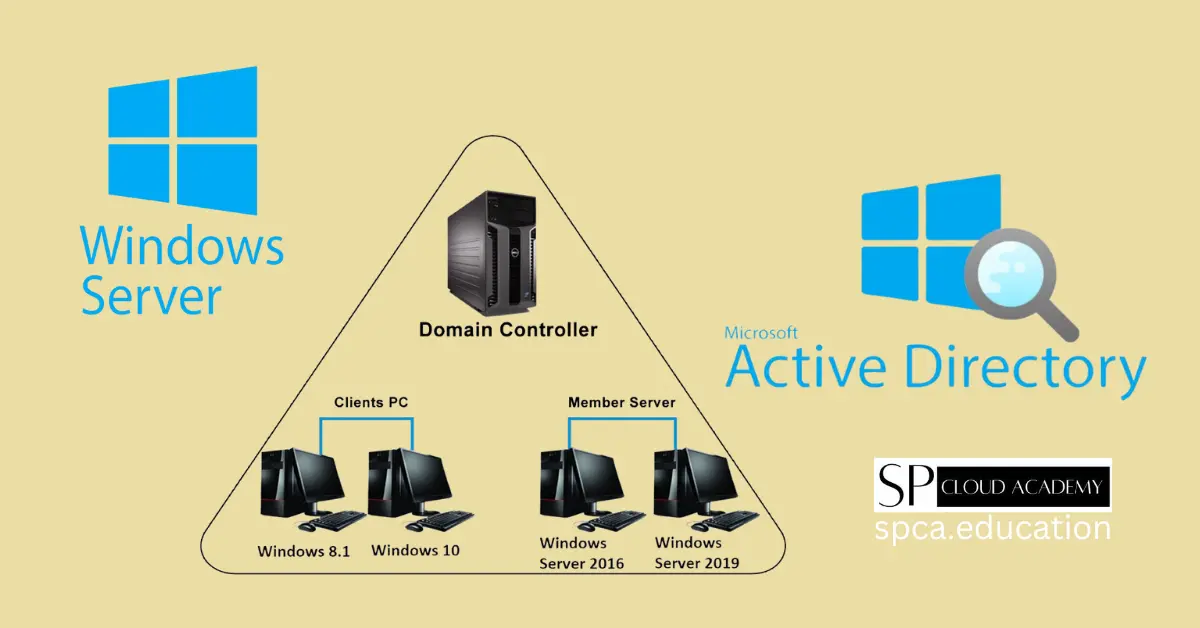Windows Server is a powerful operating system that provides a wide range of features and services for managing networks and servers. Whether you’re a beginner or an expert, understanding how to effectively utilize Windows Server for domain and active directory services is crucial. In this comprehensive guide, I will walk you through the step-by-step process of mastering Windows Server, from setting up a domain controller to troubleshooting common issues. By the end of this article, you will have the knowledge and skills to confidently manage domain and active directory services on Windows Server.
Understanding Domain and Active Directory Services
Before diving into the intricacies of Windows Server, it’s important to have a clear understanding of what domain and active directory services are. A domain is a logical grouping of computers, users, and resources that share a common security database. It allows for centralized management of users, permissions, and policies. Active Directory, on the other hand, is a directory service that stores information about objects on a network and enables administrators to manage and secure network resources. By combining the power of domain and active directory services, Windows Server provides a comprehensive solution for managing network environments.
Benefits of Using Windows Server for Domain and Active Directory Services
There are numerous benefits to using Windows Server for domain and active directory services. Firstly, it offers a high level of scalability, allowing you to easily add or remove users, computers, and resources as your organization grows. Additionally, Windows Server provides robust security features, such as access controls and encryption, ensuring that your network remains protected from unauthorized access. Furthermore, Windows Server offers a centralized management console, making it easier to administer and control your network environment. Finally, Windows Server provides seamless integration with other Microsoft products, such as Exchange Server and SharePoint, enabling you to leverage additional functionalities and improve overall productivity.
Key Features of Windows Server for Domain and Active Directory Services
Windows Server comes with a variety of key features that are specifically designed to enhance domain and active directory services. One of the most notable features is the Active Directory Domain Services (AD DS), which provides a hierarchical structure for storing information about objects on a network. AD DS enables you to efficiently manage users, groups, and resources, while also offering features like group policy management and replication. Another important feature is the Domain Name System (DNS), which translates domain names into IP addresses and vice versa, allowing for seamless communication between computers and resources on the network. Additionally, Windows Server offers features like Active Directory Federation Services (AD FS) for single sign-on across multiple domains, and Active Directory Certificate Services (AD CS) for managing digital certificates.
Step-by-Step Guide to Setting Up a Domain Controller on Windows Server
Setting up a domain controller is a fundamental step in utilizing Windows Server for domain and active directory services. Here is a step-by-step guide to help you get started:
Step 1: Install Windows Server Begin by installing Windows Server on a dedicated machine that will serve as your domain controller. Follow the on-screen instructions to complete the installation process.
Step 2: Configure Networking Once Windows Server is installed, configure the network settings to ensure proper connectivity. Set a static IP address, subnet mask, default gateway, and DNS server address.
Step 3: Promote Server to Domain Controller Next, open the Server Manager and select “Add Roles and Features”. Choose the Active Directory Domain Services role and follow the prompts to promote the server to a domain controller.
Step 4: Create a New Forest During the promotion process, you will be prompted to create a new forest or join an existing one. Select the option to create a new forest and provide a domain name for your network.
Step 5: Configure Additional Settings Configure additional settings as per your requirements, such as the location of the Active Directory database, log files, and SYSVOL folder.
Step 6: Review and Install Review the summary of your configuration settings and click “Install” to begin the installation process. Once completed, your domain controller will be ready for use.
Creating and Managing Active Directory Objects
Once you have set up a domain controller on Windows Server, you can start creating and managing active directory objects. Active directory objects represent various entities on your network, such as users, groups, computers, and printers. Here are the steps to create and manage active directory objects:
Step 1: Open Active Directory Users and Computers Open the Active Directory Users and Computers console from the Administrative Tools menu. This console provides a graphical interface for managing active directory objects.
Step 2: Create a New User To create a new user, right-click on the desired organizational unit (OU) and select “New” > “User”. Follow the prompts to enter the user’s details, such as name, username, password, and group membership.
Step 3: Create a New Group To create a new group, right-click on the desired OU and select “New” > “Group”. Specify the group’s name, description, and group type (security or distribution).
Step 4: Create a New Computer To create a new computer object, right-click on the desired OU and select “New” > “Computer”. Enter the computer’s name and specify whether it is a member of a domain or a workgroup.
Step 5: Manage Active Directory Objects Once created, you can manage active directory objects by modifying their properties, resetting passwords, assigning permissions, and more. Simply right-click on the object and select the desired action from the context menu.
Group Policy Management in Windows Server
Group Policy is a powerful feature in Windows Server that allows you to manage and enforce settings across a network of computers. It provides a centralized way to configure security settings, desktop configurations, software installations, and more. Here’s a guide to effectively manage group policies in Windows Server:
Step 1: Open Group Policy Management Open the Group Policy Management console from the Administrative Tools menu. This console provides a comprehensive view of all group policy objects (GPOs) in your network.
Step 2: Create a New GPO To create a new GPO, right-click on the desired domain or organizational unit and select “Create a GPO in this domain, and Link it here”. Enter a name for the GPO and click “OK”.
Step 3: Edit GPO Settings To edit the settings of a GPO, right-click on the GPO and select “Edit”. This will open the Group Policy Management Editor, where you can configure various policies and settings.
Step 4: Configure Group Policy Settings Within the Group Policy Management Editor, navigate to the desired policy category (e.g., Computer Configuration or User Configuration) and configure the desired settings. This can include security settings, desktop configurations, software installations, and more.
Step 5: Link GPO to Organizational Units Once you have configured the desired settings, link the GPO to the appropriate organizational units by right-clicking on the OU and selecting “Link an Existing GPO”. Select the desired GPO and click “OK”.
Step 6: Enforce and Test GPO To enforce a GPO, right-click on the GPO and select “Enforced”. This will ensure that the GPO’s settings are applied even if conflicting settings exist in higher-level GPOs. Test the GPO on a few target computers to verify its effectiveness.
Troubleshooting Common Issues in Windows Server Domain and Active Directory Services
While Windows Server provides a robust platform for managing domain and active directory services, it’s not uncommon to encounter issues along the way. Here are some common issues and their troubleshooting steps:
Issue 1: Unable to Join a Domain If you are unable to join a computer to a domain, ensure that the computer has a valid IP address and is able to communicate with the domain controller. Check the network settings, DNS configuration, and firewall settings to ensure proper connectivity.
Issue 2: User Login Issues If users are experiencing login issues, check their account status, password expiration, and group membership. Ensure that the user accounts are not locked out or disabled. Resetting the user’s password and verifying the group membership may resolve the issue.
Issue 3: Group Policy Not Applying If group policies are not applying as expected, check the GPO inheritance and enforcement settings. Verify that the target computers are in the correct organizational units and that there are no conflicting GPOs. Running the “gpupdate /force” command on the target computers may force the update of group policies.
Issue 4: Active Directory Replication Issues If you notice issues with active directory replication, check the event logs on the domain controllers for any replication errors. Ensure that the domain controllers have proper network connectivity and that the replication schedule is configured correctly. Running the “repadmin /showrepl” command can provide valuable information about replication status.
Issue 5: DNS Resolution Problems If you are experiencing DNS resolution problems, check the DNS server settings on the computers and domain controllers. Ensure that the DNS server is properly configured and that the DNS zones are replicated across domain controllers. Running the “nslookup” command can help troubleshoot DNS resolution issues.
Best Practices for Managing Windows Server Domain and Active Directory Services
Managing Windows Server domain and active directory services requires adherence to best practices to ensure a secure and efficient network environment. Here are some best practices to consider:
- Regularly Back up Active Directory: Perform regular backups of the active directory database to protect against data loss. This ensures that you can recover quickly in case of a disaster or hardware failure.
- Implement Group Policy Security Settings: Utilize group policies to enforce security settings across the network. This includes settings such as password policies, account lockout policies, and software restriction policies.
- Monitor Event Logs: Regularly monitor the event logs on domain controllers and critical servers to identify and address potential issues. Event logs provide valuable information about system health, security incidents, and performance.
- Implement Strong Password Policies: Enforce strong password policies to prevent unauthorized access to user accounts. This includes setting requirements for password length, complexity, and expiration.
- Regularly Update and Patch Servers: Keep Windows Server and other software up to date with the latest patches and updates. Regular patching helps protect against security vulnerabilities and ensures optimal performance.
- Implement Least Privilege Principle: Follow the principle of least privilege when assigning permissions to users and groups. Only provide the minimum level of access required to perform their job responsibilities.
- Perform Regular Security Audits: Conduct periodic security audits to identify and address potential security vulnerabilities. This includes reviewing user accounts, group memberships, and access controls.
Resources for Further Learning and Certification in Windows Server Domain and Active Directory Services
If you’re looking to further enhance your knowledge and skills in Windows Server domain and active directory services, there are several resources available:
- Microsoft Documentation: The official Microsoft documentation provides in-depth information about Windows Server, including domain and active directory services. It covers various topics, from installation and configuration to advanced troubleshooting.
- Online Tutorials and Courses: Many online platforms offer tutorials and courses specifically tailored to Windows Server domain and active directory services. These resources provide step-by-step instructions, practical examples, and hands-on exercises to help you master the subject.
- Windows Server Certification: Microsoft offers various certifications for Windows Server, including the MCSA (Microsoft Certified Solutions Associate) and MCSE (Microsoft Certified Solutions Expert) certifications. These certifications validate your expertise in Windows Server domain and active directory services and can enhance your career prospects.
- Online Communities and Forums: Engaging with online communities and forums dedicated to Windows Server can provide valuable insights and support. These platforms allow you to connect with experts and fellow professionals, share knowledge, and seek assistance with specific issues.
Conclusion
Mastering Windows Server for domain and active directory services is a valuable skill for any IT professional. By understanding the basics, learning the key features, and following best practices, you can effectively manage and secure your network environment. Whether you’re a beginner or an expert, the step-by-step guide provided in this article will help you navigate the complexities of Windows Server and ensure optimal performance. Remember to utilize the available resources and continuously update your knowledge to stay ahead in the ever-evolving world of IT.
See Also
Systems Engineering: https://spca.education/category/systems-engineering/
-

The Ultimate Guide to the Best Open Source Identity and Access Management Solutions
-

Windows License Types Explained: Retail vs OEM vs Volume — Which One’s Right for You?
-

Secure Boot Demystified: What It Is and Why It’s Your PC’s First Line of Defense
-

Legacy BIOS Is Dying — Here’s Why UEFI & Secure Boot Are Taking Over
-

The Power of Hypervisors: Transforming Research and Development in CS Education
-

Revolutionizing IT: What’s New in Windows Server 2025?
